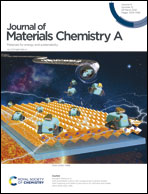Engineering highly active Cd1−xZnxS nanopopcorns via zinc blende/wurtzite phase junctions for enhanced photocatalytic H2 evolution without a co-catalyst†
Abstract
Rational structure design of semiconductor photocatalysts is meaningful to enhance their sunlight-driven hydrogen-evolution performance. Herein, we present a facile approach to prepare Cd1−xZnxS nanopopcorns with zinc blende/wurtzite phase junctions by using excess thioacetamide (TAA). The as-obtained Cd1−xZnxS samples were used for visible-light photocatalytic H2 evolution without a co-catalyst. The H2-evolution activity reaches 282.14 μmol h−1 mg−1, which is ca. 12 fold higher than that of Cd0.5Zn0.5S prepared with an equivalent dose of TAA. Meanwhile, an apparent quantum yield of 64.4% at 420 nm was achieved. Results demonstrated that the Cd1−xZnxS samples synthesized by using excess TAA improve light absorption and hydrophilicity, which is helpful for the photocatalytic reaction. Moreover, the existence of type-II ZB/WZ phase junctions promotes the separation and migration of photoinduced electron–hole pairs. This work provides a novel idea for the rational design of efficient Cd1−xZnxS-based photocatalysts.



 Please wait while we load your content...
Please wait while we load your content...